NCERT Based Activity: Keeping Time with the Skies | Science Curiosity Class 8 - New NCERT PDF Download
| Table of contents |

|
| Activity 11.1: Let us explore |

|
| Activity 11.2: Let us explore |

|
| Activity 11.3: Let us measure a day! |

|
| Activity 11.4: Let us identify |

|
Activity 11.1: Let us explore
Spot the Moon at sunrise in the western direction on the first day after the full Moon. Make a table similar to Table 11.1 in your notebook. Document the following:
- Date
- When you saw the Moon (at sunrise or sunset)?
- Shade the corresponding Circle with pencil to show the bright portion of the Moon as shown in Fig. 11.1.
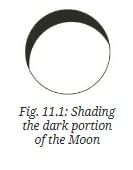
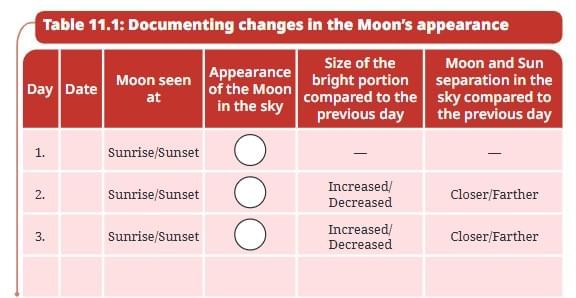
From the second day onwards also document the following:
- Is the size of bright portion of the Moon increasing or decreasing from the previous day.
- Whether the Moon appears closer to or farther from the Sun in the sky than the day before.
After about 15 days, you may not be able to see the Moon at sunrise or sunset. For the next 15 days, carry out this activity at sunset.
Table: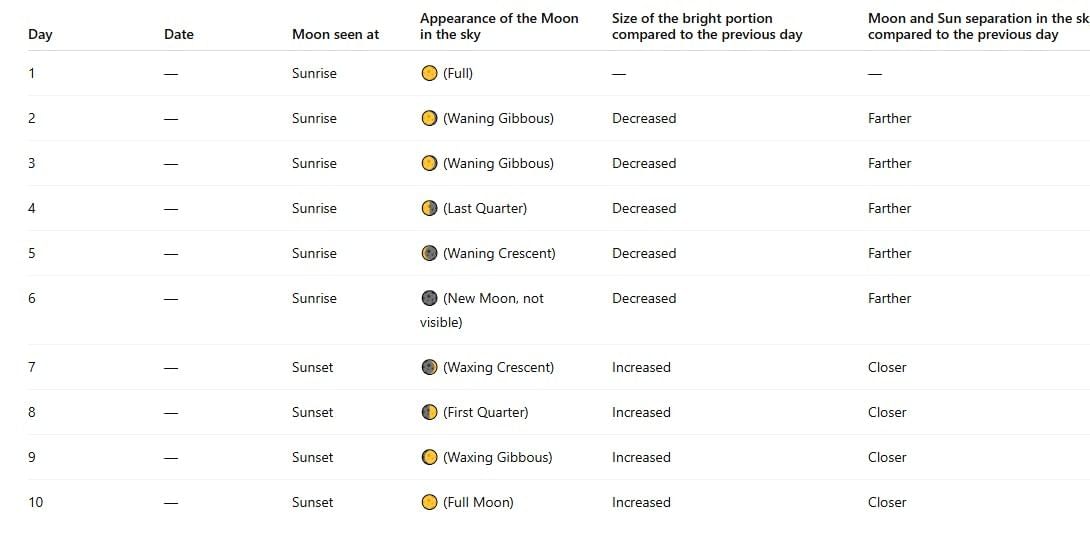
Notes / Analysis:
The Moon does not appear the same each day. Its bright portion gradually decreases after a full Moon and increases after a new Moon.
The Moon is not visible at all times; sometimes it is visible at sunrise, sometimes at sunset.
The Moon’s position relative to the Sun changes each day.
Questions and Answers:
Did the Moon appear different each day?
Answer: Yes, the Moon's bright portion changes shape daily, transitioning from a full circle to a crescent and back.Was the Moon visible on all days?
Answer: No, the Moon is not visible around the new Moon day (Amavasya).Did the Moon appear at the same position in the sky as on the previous day?
Answer: No, the Moon's position shifts, appearing closer to the Sun as the bright portion decreases, and farther during the waxing phase.
Activity 11.2: Let us explore
Take a small soft ball and insert a stick into it (Fig. 11.4a). This represents the Moon.
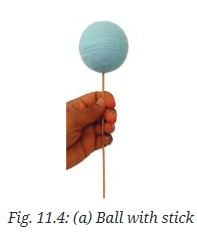
Go to a dark open place (at night), and ask a teacher or guardian to shine a torchlight towards you from about 3 m to represent light coming from the Sun or stand near an electric lamp. Your head represents the Earth.
Now hold the ball at arm’s length in one hand such that it is slightly above your head as shown in Fig. 11.4b. Keep the ball at position E towards the direction of the lamp. Does the portion of the ball facing you appear to be illuminated or not?
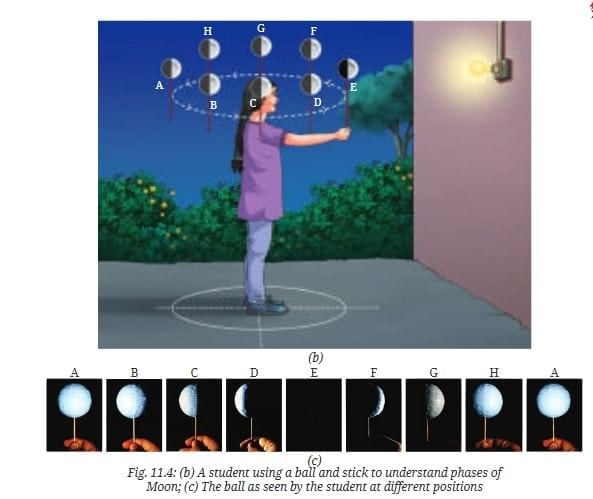
Turn around slowly, in the anti-clockwise direction, with your arm outstretched as shown in Fig. 11.4b and keep looking at the ball. Does the shape of the illuminated portion change? Is the line separating the illuminated and non-illuminated portions of the ball curved?
Was your observation similar to the changing shape of the illuminated portion of ball shown in Fig. 11.4c?
Questions and Answers:
Does the portion of the ball facing you appear to be illuminated or not?
Answer: No, at position E, the portion facing you is not illuminated.Does the shape of the illuminated portion change?
Answer: Yes, the shape changes as you turn, showing different illuminated portions.Is the line separating the illuminated and non-illuminated portions of the ball curved?
Answer: Yes, the line is curved, similar to the Moon's phases.Was your observation similar to the changing shape of the illuminated portion of ball shown in Fig. 11.4c?
Answer: Yes, the changes match the phases shown in Fig. 11.4c.
Activity 11.3: Let us measure a day!
Find a small flat area in a ground which receives sunlight during the day. Fix a 1 m stick vertically in it as shown in Fig. 11.7.
Start observing at 11:00 a.m. Every minute, mark a dot on the ground at the tip of the stick’s shadow. Keep marking dots until around 1:10 p.m.
Identify when the shadow was shortest and find out its time by counting the number of dots. Record this time in Table 11.2. Repeat this exercise for the next few days.
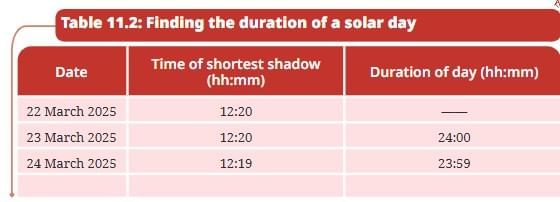
Find the duration of the solar day by finding a difference in time on two consecutive days as shown in Table 11.1.
Completed Table: 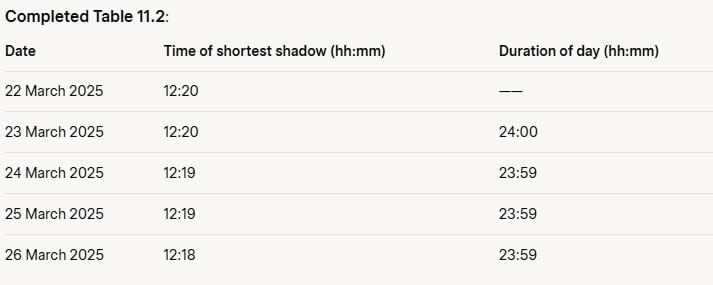
Questions and Answers:
Find the average duration of the day. Is it nearly equal to 24 hours?
Answer: Yes, the average duration is approximately 24 hours, as seen from the slight variations in Table 11.2 (e.g., 23:59 to 24:00).
Activity 11.4: Let us identify
Spotting an artificial satellite is a night sky watching activity like we have done previously. Just before sunrise or after sunset, go to a location, accompanied by an adult, that has a clear view of the sky, without any obstruction of trees or tall buildings.
To identify satellites in the sky, look for any moving object in the sky that appears as a point of light with steady or flickering brightness and is moving very fast across the sky. You can see them with the naked eye or with binoculars.
You may use mobile apps or websites that provide details of satellites visible in your location and when they will be passing above you in the sky.
|
59 videos|236 docs|13 tests
|
FAQs on NCERT Based Activity: Keeping Time with the Skies - Science Curiosity Class 8 - New NCERT
| 1. What are the primary methods used to keep time based on natural phenomena? |  |
| 2. How did ancient civilizations measure a day? |  |
| 3. What is the significance of the Earth's rotation in keeping time? |  |
| 4. How do modern clocks differ from traditional methods of keeping time? |  |
| 5. Why is understanding the concept of time measurement important in daily life? |  |














